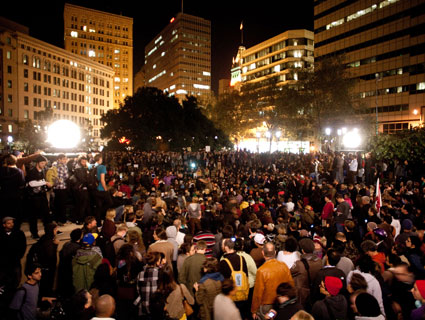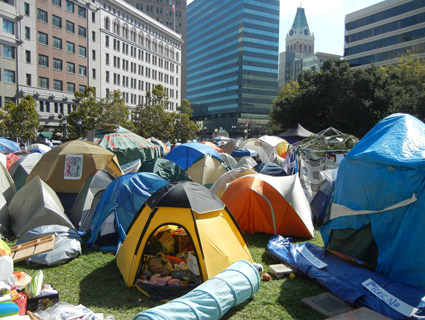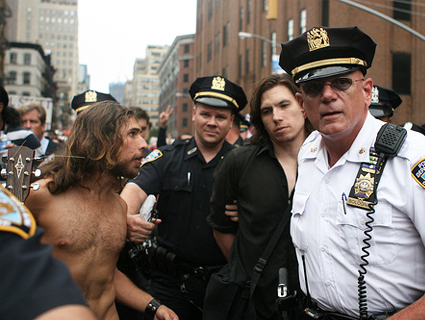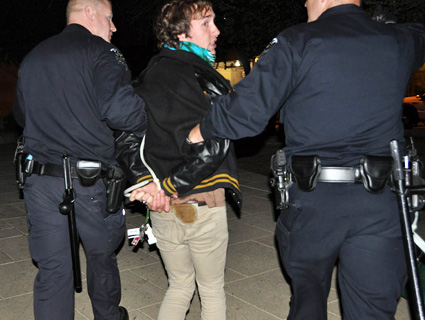Violence came in waves. Many demonstrators peace-saluted police and called through bullhorns: “This is a peaceful protest! This is a civilian movement!” But from the moment I arrived in Oakland at 10:15 p.m., I saw a visible minority spoiling for conflict. Tinder had built across the night at the intersection of 14th Street and Broadway, a mixture of expectation and adrenaline. Protesters had balked at what they saw as disproportionate policing: They’d been teargassed once already. But how to respond was a matter of intense debate in the crowd of about 1,000.
People shouted each other down while police—as many as 100, in full riot gear, from several different counties—bristled in their formation behind a single metal barricade; news and police helicopters provided the soundtrack. Xavier Manalo, a 25-year-old tennis instructor holding the forward-most protest banner, admitted there were “rogue elements” in the group but insisted the “pressure of the peaceful will be the deterrent” to the violence.
Manalo was wrong. I saw groups of protestors arguing, not only with the police—who were the constant subject of heckling and catcalls—but with each other. There were calls to retaliate by throwing things like eggs back over the barricade, just as a big group of around 40 people started to chant, “Don’t Throw Shit! Don’t Throw Shit!”
Time passed and restlessness set in. Another fight broke out in front of me.
“You don’t need to be splitting this fucking movement!” one man yelled at a guy holding a bullhorn who had been trying to reassure police of the group’s peaceful motives. He was angry that the man with the megaphone had characterized a group of demonstrators as violent. “You don’t have to be doing their fucking work for them!” he yelled.
No one appeared in control and the group was divided into two groups: the largely peaceful, and a small, visible, determined group of agitators.
At the height of this melee, I saw two men throw bottles at the police. People screamed and scrambled for air ahead of the inevitable: a half-dozen canisters of tear gas—some crackling and echoing off the Rite Aid building. Caught up in taking pictures, I breathed and choked. It felt like I had swallowed chilies and then rubbed the chilies into my eyes for good measure. I heard reports of rubber bullets and saw demonstrators tending to the distressed. My Twitter feed told me of at least one bloody injury—a man hit in the head with a canister—but the gas made the intersection impossible to rejoin for 10 minutes to confirm injuries.
A brief lull, then this scene repeated. The group came back together—around 800—with protesters calling to those who were still cowering behind bus shelters or cleaning their eyes to “not be afraid,” to “not run away.” And so it began again: talks, disagreements about engagement, improvised debates about the meaning of nonviolence, and a swirling sense of anticipation.
The breaker: Another bottle was hurled from the crowd and tear gas canisters were lobbed back. Accord between the protestors had not been reached.
In the end, the group waned, the police swelled, and there was a steady stalemate at the metal perimeter of the intersection—not only between protesters and police, but also between protesters and other protesters. People circled on bicycles; meditators chanted, eyes clenched; and reporters simply waited.
“Occupy Oakland is no longer playing a part in this protest,” one officer told me—rogue actors, he suggested, had taken control. And indeed by midnight, the earlier calls for peace had fallen away to catcalls and heckling.
“We’re losing if we’re losing people,” said a 24-year-old protester who said his first name was LaMarr. “It’s about to be over soon.”
As the protesters filtered away, I spoke with a group of tired cops covered in blue and orange paint—and that wasn’t all, said one sergeant who wouldn’t give his name. He said they’d also been pelted with glass and vinegar, and one officer claimed to have tasted urine in the mix. So how did tonight compare with others he’s seen? He laughed and said, “Well, it’s not quite a homicide.”
















